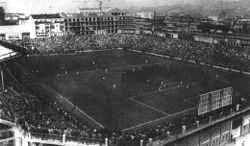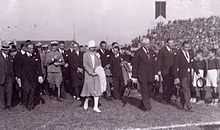Stadio Filadelfia
| Stadio Filadelfia | |
 | |
| Full name | Campo Torino |
|---|---|
| Location |
Via Filadelfia, 36 Filadelfia Lingotto Turin |
| Coordinates | 45°02′19″N 7°39′29″E / 45.038498°N 7.65819°E |
| Owner | Community of Turin |
| Capacity | 30,000 |
| Field size | 110 x 70 m |
| Surface | Grass |
| Construction | |
| Broke ground | 1926 |
| Opened | 1926 |
| Renovated | 1946 (post-WW2 bombardment) |
| Closed | 1963 |
| Demolished | 1998 |
| Construction cost |
2,500,000 lire 8,000,000 lire (1946 reconstruction) |
| Architect | Miro Gamba |
| Tenants | |
|
| |
The campo Torino (known as the Stadio Filadelfia) was a small multi-use stadium in Turin, Italy, situated in Borgo Filadelfia, in the Lingotto district. It takes its nickname from the street on which it was built, and hosted Torino's home games for more than thirty years.
History
Construction
The stadium was designed by Count Enrico Marone Cinzano, the president of Foot-Ball Club Torino. Enrico Marone created the Società Civile Campo Torino, with a grant, and the sole aim to buy the land and build a stadium with an adjacent training ground.[1] On 24 March 24, 1926 the building permit was requested and, following its acceptance, jobs were assigned to the engineer Miro Gamba, professor of the Polytechnic University of Turin;[2] the construction work was commenced by the Commendatore Riccardo Filippa.[3] The land, at that time, on the outskirts of Turin, was chosen for the low cost of the area.[4]

The construction occupied five months, and just under two and a half million lire.[1] The inauguration took place on 17 October 1926 and marked by a friendly between Torino and Fortitudo Roma, in the presence of Crown Prince Umberto II, Princess Mary Adelaide and an audience of 15,000 spectators. The field was blessed before the match by the Archbishop of Turin, Giuseppe Gamba and ended with the victory of Torino 4–0.
The structure
Originally the stadium covered an area of 38,000 m² enclosed by a wall; it consisted of only two stands, with a capacity of 15,000 (1300 in the central grandstand, 9500 on the bleachers, 4000 in the parterre). The parterre was situated under the grandstand, arranged by 13 rows.[1] The Stadio Filadelfia's bleachers were cement, while the stands were wooden and cast iron built Art Nouveau style.[5] The seating in the forum was made of wood, and all numbered. The wall around the structure was 2.5 meters high.

The facade was made of red brick, with columns and large windows with white frames. The various windows were connected by a gallery with iron railings. At the front was an old field that was used for training in the 1930s.[5] The main structure of the building was reinforced concrete, while the stands were composed of pillars supporting a network of longitudinal wooden trusses on which panels of asbestos were placed. The parterre was instead formed by masonry. The support of the flag which was located at the entrance was about 6 meters high; its base was covered with bas-reliefs depicting a Greco Deco style.[1] The field measured 110x70 meters and was covered with grass and had a drainage system. Under the stands was the caretaker's apartment, and fourteen rooms that were used by the players and the referee, the infirmary, club officials, and a hall for refreshments. Players could reach the field from the changing rooms through an underpass.[1] The stadium also underwent extension work. In 1928 a box office was added, and in 1932, the grandstand was expanded bringing the total capacity to 30,000 people.[1][3]
The Grande Torino
The stadium hosted Torino's home matches until 1962–63. It was the site of six of their seven Serie A titles (not counting the one revoked in 1927) and the stage they remained unbeaten for six years, 100 consecutive matches, from 17 January 1943 to the Superga air disaster, including the famous 10–0 victory over Alessandria (still a record in Serie A).[6] It was here that Oreste Bolmida performed (the trumpeter fan then made famous by the movie Ora e per sempre).[5] On 13 July 1943, in the middle of World War II, the Filadelfia was also bombed. Of the damaged parts were the field (used by the Allies to play baseball) and the stands near via Giordano Bruno. Despite the coverage the grandstand remained intact, although the metal beams were removed, probably to supply the arms industry, and replaced with wood.[4] The Filadelfia became unusable for a long time, and the 1943–44 season was played at the Stadio Motovelodromo Umberto I. Torino would later move to the Stadio Mussolini, the future Stadio Comunale.[6] After the war, renovations were carried out by the new club president Ferruccio Novo.[7]
Abandonment
After Superga the president Ferruccio Novo guaranteed the stadium to the Italian Football Federation, and even thought of possibly demolishing it.[8] In the post-war period the area of the Filadelfia became residential, and it was thought to demolish the stadium to build new buildings. In 1959 the stadium became "public space", and the project failed.[9] In the 1958–59 season, Torino, denominated "Talmone Torino" for sponsorship reasons, moved to the Stadio Comunale: the season ended with relegation to Serie B. The following year, because of superstition, the team returned to play at the Filadelfia, and stadium became Torino's home again for a few years. On 19 May 1963 the last official match was played, a Torino - Napoli, finishing 1–1, with goals from Bearzot (T) and Corelli (N). The following season the Granata moved permanently to the Comunale, which they had begun to occasionally use, especially for bigger matches and consequently, with greater affluence.
In 1970 the first attempt was made to recover the Filadelfia, when Torino's president was Orfeo Pianelli; the Società Civile Campo Torino began the renovation project. The idea was to allow the first team to train on the field and the construction of a gymnasium. The project suffered from problems and, in 1973, was cancelled because the area was still classified "public space".[9] Pianelli's idea involved the demolition of the structure, the construction of playing fields and accommodations for the youth team. The original plan failed because Pianelli received death threats. On 18 October, a building permit was issued, but only for minor renovations, provided for an annual fee.[10] Torino continued to train here up until 1989, when they moved to a modern structure in Orbassano, leaving the training ground to the youth team.[9] The maintenance was abandoned, however, and in a few years the stands deteriorated. In the 1980s the degradation had an exponential growth, mainly because of the concrete used in construction, leading to a partial collapse of the structures.
References
- ↑ 1.0 1.1 1.2 1.3 1.4 1.5 Tesi. La costruzione del mito del "Fila".
- ↑ Il simbolo del Borgo Filadelfia
- ↑ 3.0 3.1 Il Filadelfia
- ↑ 4.0 4.1 Tesi. Prima del Filadelfia.
- ↑ 5.0 5.1 5.2 La Repubblica - Il salotto Liberty dei proletari
- ↑ 6.0 6.1 Il Grande Torino
- ↑ AECT, Società Civile Campo Torino. Cemento armato. Via Filadelfia 40 circa., n. 17c, a. 1945
- ↑ Collino Manlio, Delenda Carthago, Philadelphia restituendum est, «Fegato Granata», Torino, settembre 2001
- ↑ 9.0 9.1 9.2 Tesi. "3 - Il lento declino".
- ↑ AECT, Autorizzazione della Comm. Igien. Edilizia a costruire il capannone provvisorio ad uso palestra, via Filadelfia n. 40, 18 ottobre 1973, prot. 857, contenuto nella cartella «Capannone uso palestra», richiesta della Soc. Torino Calcio, via Filadelfia n. 40, I cat., a. 1973, n. prat. 885
External links
![]() Media related to Category:Filadelfia Stadium of Turin at Wikimedia Commons
Media related to Category:Filadelfia Stadium of Turin at Wikimedia Commons